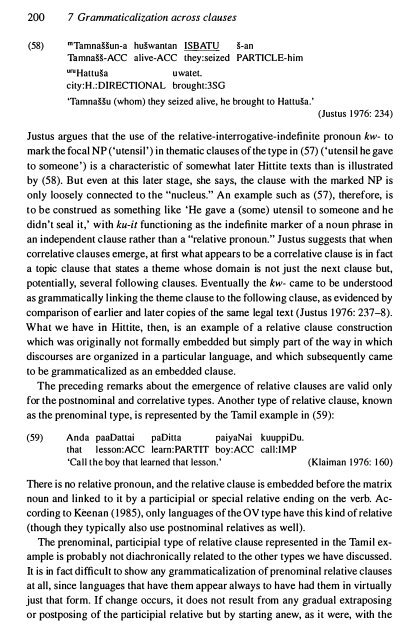Gram - SEAS
Gram - SEAS
Gram - SEAS
Create successful ePaper yourself
Turn your PDF publications into a flip-book with our unique Google optimized e-Paper software.
200 7 <strong>Gram</strong>maticalization across clauses<br />
(58) mTamnaun-a huwantan ISBATU -an<br />
Tamna-ACC alive-ACC they:seized PARTICLE-him<br />
uruHattua uwatet.<br />
city:H.:DlRECTIONAL brought:3SG<br />
'Tamnau (whom) they seized alive, he brought to Hattua.'<br />
(Justus 1976: 234)<br />
Justus argues that the use of the relative-interrogative-indefinite pronoun kw- to<br />
mark the focal NP (,utensil') in thematic clauses of the type in (57) (,utensil he gave<br />
to someone') is a characteristic of somewhat later Hittite texts than is illustrated<br />
by (58). But even at this later stage, she says, the clause with the marked NP is<br />
only loosely connected to the "nucleus." An example such as (57), therefore, is<br />
to be construed as something like 'He gave a (some) utensil to someone and he<br />
didn't seal it,' with ku-it functioning as the indefinite marker of a noun phrase in<br />
an independent clause rather than a "relative pronoun." Justus suggests that when<br />
correlative clauses emerge, at first what appears to be a correlative clause is in fact<br />
a topic clause that states a theme whose domain is not just the next clause but,<br />
potentially, several following clauses. Eventually the kw- came to be understood<br />
as grammatically linking the theme clause to the following clause, as evidenced by<br />
comparison of earlier and later copies of the same legal text (Justus 1976: 237-8).<br />
What we have in Hittite, then, is an example of a relative clause construction<br />
which was originally not formally embedded but simply part of the way in which<br />
discourses are organized in a particular language, and which subsequently came<br />
to be grammaticalized as an embedded clause.<br />
The preceding remarks about the emergence of relative clauses are valid only<br />
for the postnominal and correlative types. Another type of relative clause, known<br />
as the prenominal type, is represented by the Tamil example in (59):<br />
(59) Anda paaDattai paDitta paiyaNai kuuppiDu.<br />
that lesson:ACC leam:PARTIT boy:ACC call:IMP<br />
'Call the boy that learned that lesson.' (Klaiman 1976: 160)<br />
There is no relative pronoun, and the relative clause is embedded before the matrix<br />
noun and linked to it by a participial or special relative ending on the verb. Ac<br />
cording to Keenan (1985), only languages of the OV type have this kind of relative<br />
(though they typically also use postnominal relatives as well).<br />
The prenominal, participial type of relative clause represented in the Tamil ex<br />
ample is probably not diachronically related to the other types we have discussed.<br />
It is in fact difficult to show any grammaticalization of prenominal relative clauses<br />
at all, since languages that have them appear always to have had them in virtually<br />
just that form. If change occurs, it does not result from any gradual extraposing<br />
or postposing of the participial relative but by starting anew, as it were, with the
















